Seeking Purpose Through Designed Experiences
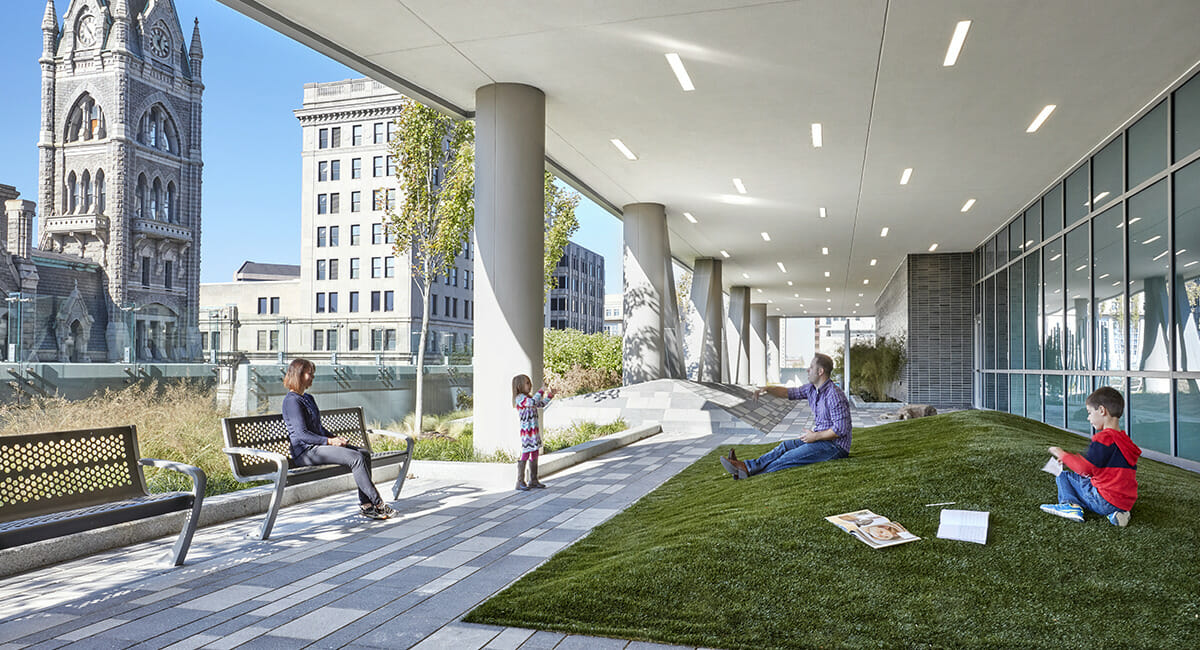
The Sky Garden at the Children’s Hospital of Richmond Pavilion. (HKS/Garrett Rowland)
By Susan Chung
What makes us human? With technology advancements taking leaps and bounds while pushing our intellectual boundaries, what is our core identity and purpose in this fast-paced, ever-changing world? The art and science of being human—what makes us unique beings—is in the thinking and creating that we do, and our brains are at the center of it all.
The brain is a powerful yet delicate organ that adds character to our lives. It uses 20% of its total energy and oxygen intake but is about 2% of the body’s total weight. It’s an evolving organ that has the ability to grow, build, and recover throughout our lifetime (neuroplasticity). The brain can process an image that we’ve seen for as little as 13 milliseconds and is capable of 1016 processes per second. It can generate a total of 70,000 thoughts per day with a virtually unlimited storage capacity. But when areas in the brain are no longer used, those neural connections fade away (pruning), and we can lose brain cells, and/or the connections in between, due to injury (neuronal loss). We need constant and continuous care for our brains, as we do for our bodies, to have them be healthy.
Brain Health for an Enriched Life
Brain health is an emerging and growing concept that entails the brain’s development, plasticity, functioning, and recovery over one’s lifespan. The World Health Organization (WHO) defines good brain health as, “a state in which every individual can realize their own abilities and optimize their cognitive, emotional, psychological, and behavioral functioning to cope with life situations” (17). We can strive for brain health by 1) understanding the brain overall – the numerous interconnected social and biological determinants that influence how the brain develops, functions, adapts, and responds to situations, 2) realizing our own capabilities and the opportunities afforded to us, and 3) activating strategies that promote brain fitness and prevent deterioration across the life span. Knowing the importance of brain health and learning how to exercise our brains intentionally can enhance the quality of our lives. For example, having a sense of purpose in life is a strong predictor of better brain health, with benefits including lower levels of depression, anxiety, and cognitive decline (Center for BrainHealth). Having an aim in life, or multiple goals throughout life, motivates us to engage with others, participate in activities, learn new skills, plan next steps, etc. Research also suggests that a moderate amount of social engagement can help process feelings, make decisions, and feel rewarded (Felix et al. 1031). Social ties can strengthen neural networks and stimulate attention and memory (Bilodeau). Brain health is intricately interconnected to living an enriched life.
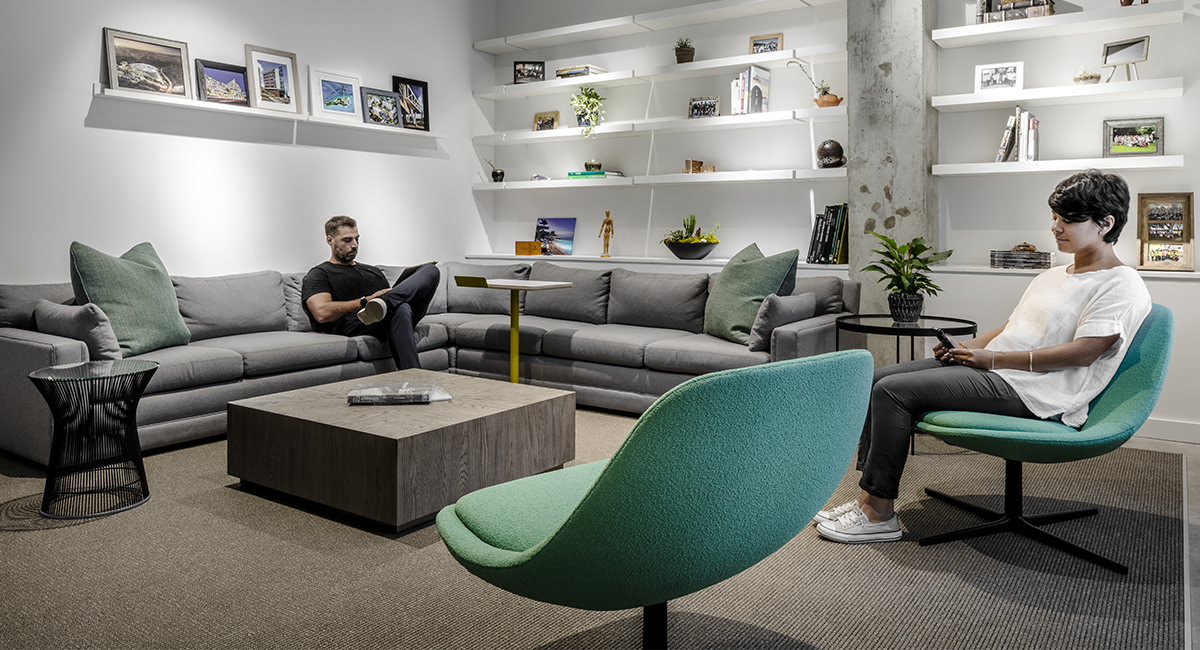
The “Living Room/Lounge” area at the HKS Miami office. (HKS/Kris Tamburello)
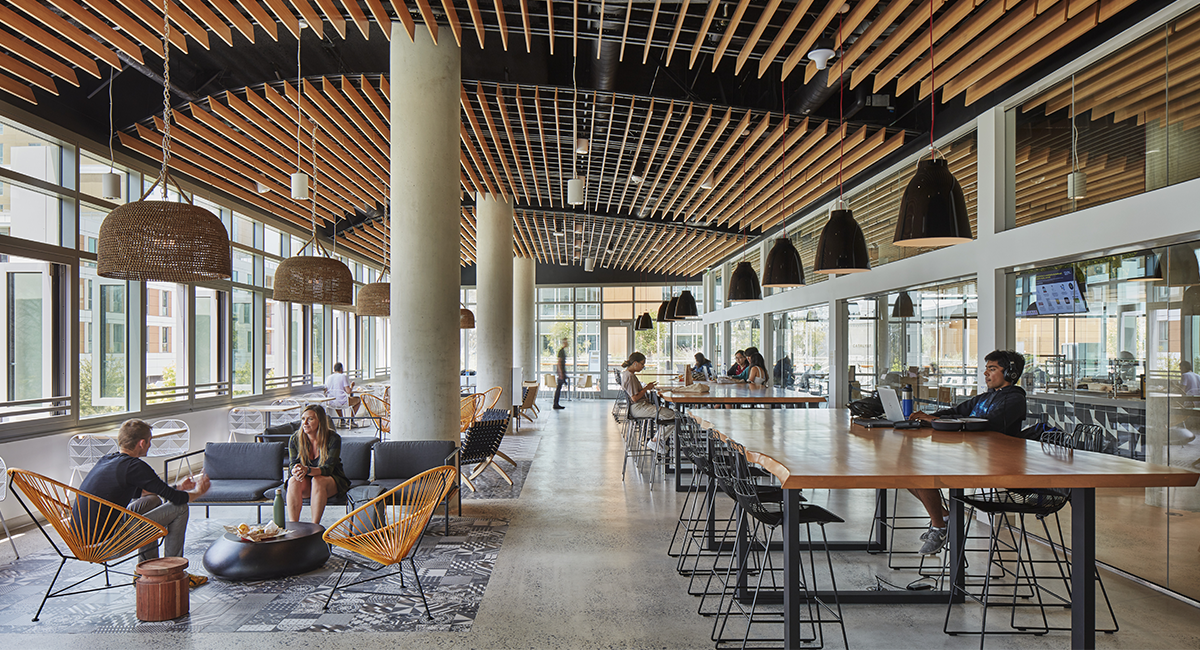
The dining hall at the UC San Diego’s North Torrey Pines Living and Learning Neighborhood (NTPLLN) incorporates human social dynamics, psychological needs and learning behaviors to enhance social, mental and physical well-being. (HKS/Tom Harris)
Brain Health Strategies and Habits
We continue to learn more about the brain as the field of neuroscience evolves but what are some tactical steps we can take now to exercise brain health? Cognitive training has multiple positive effects including faster information processing (Motes et al. 78) and improvement in self-reported depression, anxiety, and stress over time (Laane et al. 4). The cognitive training included in these studies taught brain health strategies related to strategic attention, integrated reasoning, and innovation, developed by the Center for BrainHealth®. We can learn how to think and create in ways that nourish our brains.
We can apply brain health strategies in our everyday – especially when we make it a habit – but we may not be able to do so anywhere nor everywhere. An architecture and design firm (HKS, Inc.) partnered with the Center for BrainHealth to explore the role of place, process, and technology in brain healthy workplaces. Nanda and colleagues not only found improved brain health, as measured by the BrainHealth Index, with cognitive training (consistent with previous studies), but also saw potential in improvement when offices had spaces that were conducive to the strategies (7). Their research also showed that challenges in the environment, such as noise or disruptions, can deter us from reaching peak performance when we need to focus (8), and that multitasking is detrimental to our overall work experience and satisfaction with individual work effectiveness, and can lead to increased burnout (9). Multitasking behavior not only puts a toll on our cognitive reserves but also tethers us to our workstations, making us static in the environment. With the increase in working with others virtually, we are prone to generating more noise at our workstations and disturbing our neighbors. The places we conduct our activities may be conducive to one activity type but not for all (10). For example, the best place to connect with other people may not be conducive to getting focus work done. In some cases, our surroundings may become a deterrent – having too many distractions, especially from noise, and having a lack of environmental control can disable us from reaching our capabilities. Focus work may be best when done remotely (e.g., work from home) whereas, collaborative work may be better when in-person. The research demonstrated that when we are using a range of spaces beyond our workstation, we have higher satisfaction with our collaborative work effectiveness (10).
Some changes that the offices put into effect during the study are areas for focus work that were either designated for quietude (e.g., focus room/ quiet zones) or accompanied by environmental and/or behavioral cues that signaled “do not disturb” (e.g., red flags at the workstations) (8). Some offices set up space for ideation and rapid prototyping to encourage ideation and creative collaboration. Offices saw a behavioral change in how employees used these spaces after activation. Brain healthy workplace habit recommendations include being intentional with where you work based on what you are working on, planning for a good balance of activities during the day with brain breaks in between and a variety of spaces used/visited that support each activity, and connecting with others in meaningful activities to help establish a sense of balance and coherence.
The study suggests that workplaces designed with qualities that meet their goals, combined with good workplace habits, can result in better brain health. This ultimately serves better individual and organizational health.
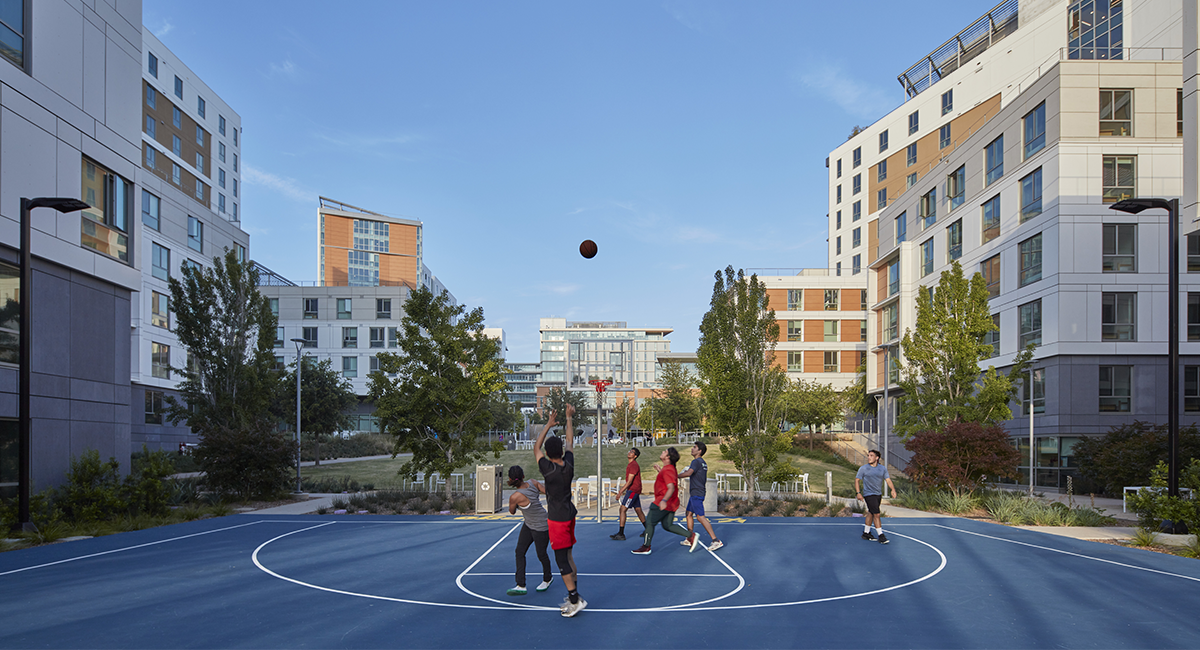
A basketball court located at the living and learning community in the UC San Diego campus promotes well-being and fosters a meaningful connection between the university and its community. (HKS/Tom Harris)
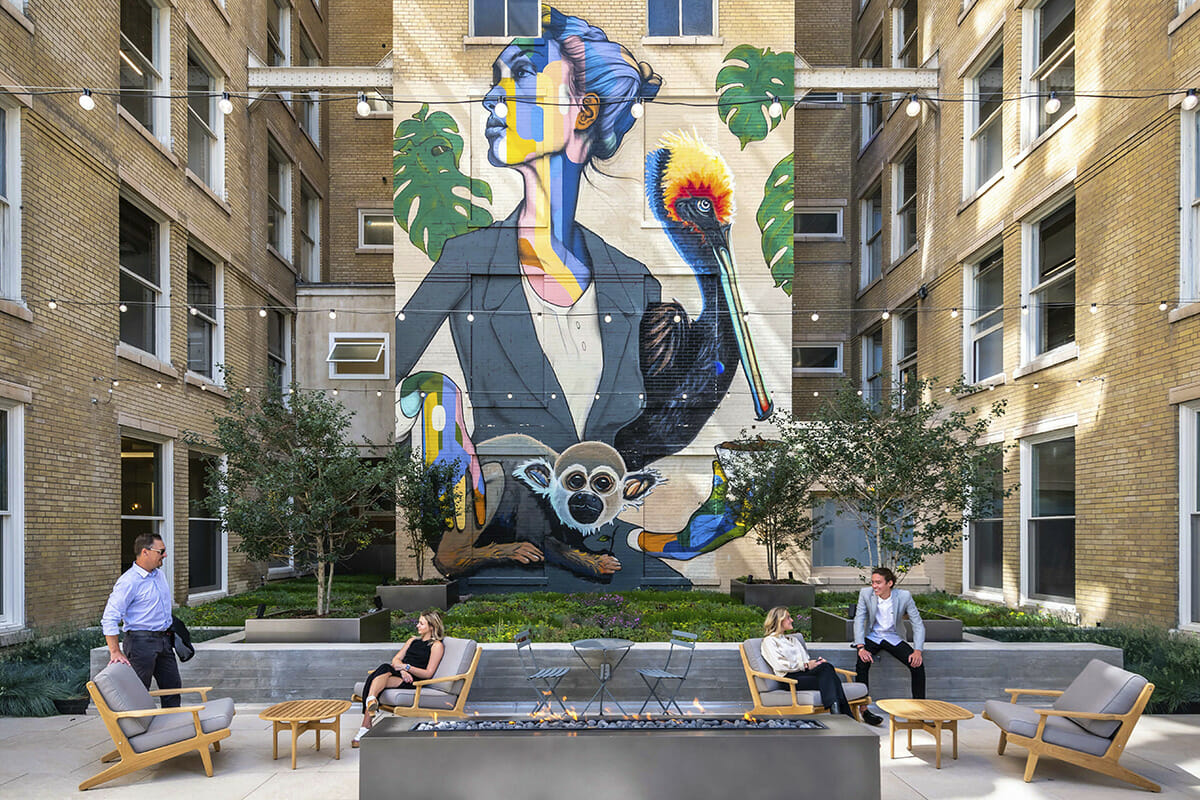
An exterior patio on the second-level roof connected to a tenant break room provides an urban oasis with sweeping views of downtown Salt Lake City from the Kearns Building. (HKS/Jack Madsen III)
Brain Health Spaces and Enriched Environments
With intentionality, brain health can be achieved anywhere. Places can be designed to enable us to have meaningful experiences that support our brain health. Nanda and colleagues suggest several space affordances (i.e., how we perceive environments to meet our needs) – namely for focus, exploration/ideation, collaboration/co-creation, rest/reflection, and social connection. When we’re in a space that has minimal distractions and/or we have control to minimize distractions, we can focus. Exploration/ideation comes from serendipitous interactions, inspirational materials, and stimulating environments that activate curiosity and learning. Collaboration/co-creation is catalyzed when having access to resources and flow. Rest/reflection can be seen as having introspective focus and oftentimes preferred to do so in nature that provide serenity. Social connection can be further promoted through pockets of spaces with furniture that is used for engagement and congregation. The design of spaces can communicate messages of how to best use the space for a particular activity.
Brain health strategies go beyond just cognition – they can be action-related (e.g., physical activity, nutritional diet, sleep) and socio- emotion-related (e.g, mindfulness, social connection), too. In a review of how design relates to neurogenesis, HKS, Inc. and HUME state that enriched environments, designed with sensory, physical, cognitive, and social stimuli that evoke positive behavioral changes, can preserve cognitive abilities, including memory (22). For example, clearly defined, less cluttered spaces can make information retrieval easier and quicker. Familiarity with a space from multiple experiences and/or engagements and environmental cues can also help with recalling information. The combination of enrichment and engagement create “complex-place contexts” that can help with cognitive activity and reducing stress. In fact, the research suggests that enriched environments can also support neurogenesis, making new connections and stimulating brain activity easier, especially for aging populations.
All activity is conducted within some physical space. When we engage with our physical surroundings, we can enhance our experiences and activities toward creating a pathway for brain health. Most spaces offer opportunities to engage with the environment – common spaces being a good representation of how we can activate specific brain areas. For example, gyms, courts, and parks encourage movement and the exercise of sensory motor skills. These spaces invite people to engage in physical activity using environmental cues that promote a particular interest (e.g., hoop and court signals playing basketball). Places that are entrenched with stimuli that harmoniously come together to evoke beauty invigorate our visual skills. Moderate amounts of complexity in environments promote creative activity – whether it be inspirational or supportive of the task. Nature is a great example for not only nourishing the brain with sensory cues but also restoring the brain to find reserves for creativity. Paths in nature guide us in exploring our surroundings, activating our senses, and regenerating our cognitive skills. When we can’t find the chance to access or don’t have access to nature, we can oftentimes design nature to be close to us. Biophilic design that brings nature into a space, natural analogues that remind us of nature, and/or forms in nature that evoke feelings of when we’re in nature can reduce stress, improve cognitive function and creativity, improve our well-being, and expedite healing (Browning et al. 9). Common spaces meant for connecting with others such as, lounges, cafes, and even lobbies can strengthen our socio-emotional skills. Coming together and sharing an experience can create deep meaning and purpose.
Designing Intentional Time and Space
An enriched life that thrives comes with intentionality. Returning to WHO’s definition of good brain health, we need to first realize our capabilities and then optimize them to fully live out our lives. Similarly, the spaces around us can help achieve brain health but we need to first realize its capabilities and then optimize the activity by finding the appropriate place. We may realize more about environments than we think we do through the information we’ve acquired in our experiences with various spaces. But we can only activate the optimization opportunity when we intentionally seek spaces with purpose, or, perhaps, to find purpose.
Common spaces, those that are shared or public, are most likely used for social interaction, recreation, relaxation, or reflection which can overall aid in cognitive regeneration and community restoration. These spaces can be purposefully visited alone or together and can be experienced in solitude or with others. When aligning with brain health strategies and space affordances, common spaces have an immense potential to activate brain health.
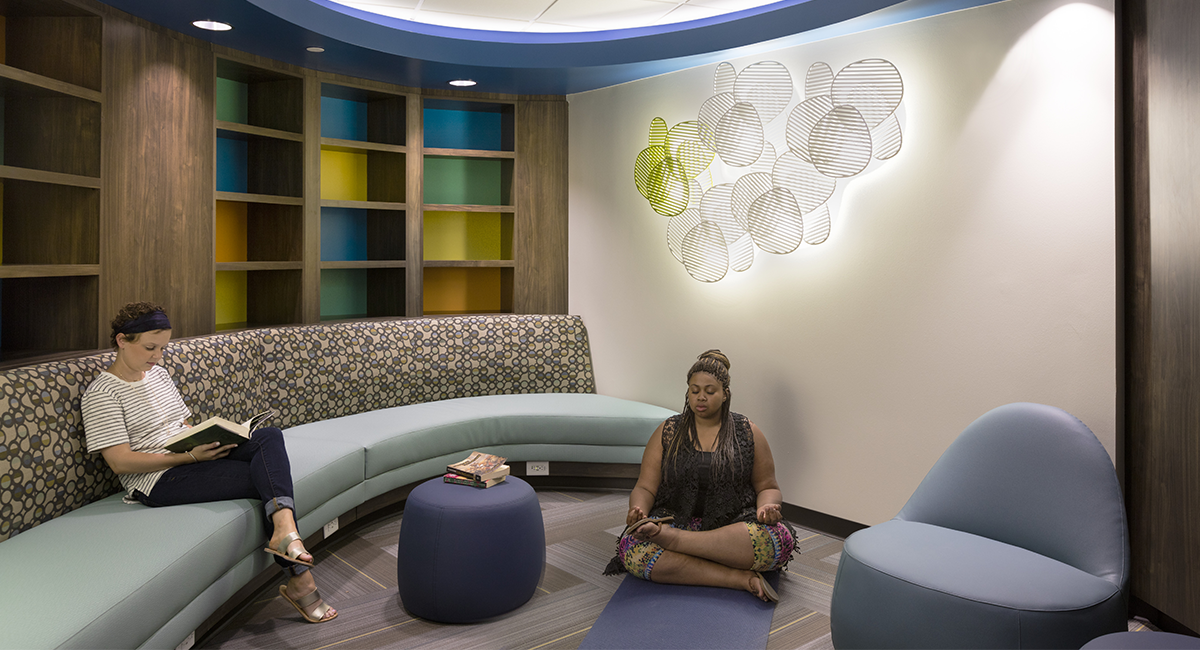
Forth Worth Baylor Scott & White All Saints Adolescent and Young Adult Cancer Unit. (HKS/Daryl Shields)
For us to live with purpose, our time should be spent intentionally to create experiences, and those experiences can be enhanced from our surroundings. The enriched life comes from designing and cultivating our time and space and nurturing a strong foundation for this to be realized. The time we take to fully experience and enjoy places can boost our mood, motivation, and attention, and help regulate movement, learning, and emotional responses. Our brain is more than the command center for our body that processes information for us to live our lives. It is more than the knowledge center for our mind that accumulates information for us to grow our intelligence. It is what makes us human and what makes each of us alive with purpose. It is also what connects us with others. The design and experience of brain health spaces will not only enrich our lives but also the health of our organizations and our communities.
Key Takeaways:
- Knowing the importance of brain health and learning how to exercise it can enhance the quality of our lives.
- We can apply brain health strategies in our everyday – especially when we make it a habit.
- When we engage with our physical surroundings, we can enhance our experiences and activities toward creating a pathway for brain health.
- With intentional design and intentional use, brain health can be achieved anywhere.
Works Cited:
1. Bilodeau, Kelly. “3 Ways to Build Brain-Boosting Social Connections.” 8 Sep. 2021, Harvard Medical School Harvard Health Publishing. https://www.health.harvard.edu/blog/3-ways-to-build-brain-boosting-social-connections-202109082585.
2. Browning, William, et al. 14 Patterns of Biophilic Design. 2014. New York: Terrapin Bright Green LLC.
3. Center for BrainHealth. “How Do Feelings of Purpose Affect Your Brain Health?” https://centerforbrainhealth.org/article/find-purpose-to-motivate-your-thinking. Accessed 6 Jan. 2023.
4. Felix, Cynthia, et al. “Greater social engagement and greater gray matter microstructural integrity in brain regions relevant to dementia.” The Journals of Gerontology: Series B 76.6 (2021): 1027-1035.
5. HKS, Inc. & HUME. “Enriched Environments for Brain Health that Foster Creativity, Promote Positivity, and Reduce Stress: A Neurogenesis Hypothesis.” 24 June, 2021. https://www.HKSinc.com/how-we-think/research/enriched-environments-for-brain-health-that-foster-creativity-promote-positivity-and-reduce-stress-a-neurogenesis-hypothesis/.
6. Laane, Sarah A., et al. “Effects of online brain training on self reported mental health symptoms for generally healthy adults during the Covid 19 pandemic.” Brain and Behavior 13.1 (2023): e2853.
7. Motes, Michael A., et al. “Higher-order cognitive training effects on processing speed–related neural activity: A randomized trial.” Neurobiology of Aging 62 (2018): 72-81.
8. Nanda, Upali, et al. “Creating a Brain Healthy Workplace.” HKS, Inc. 22 Feb. 2023. https://www.hksinc.com/how-we-think/reports/getting-to-a-brain-healthy-workplace/
9. World Health Organization. Optimizing Brain Health Across the Life Course: WHO Position Paper. Geneva: World Health Organization; 2022. License: CC BY-NC-SA 3.0 IGO; https://creativecommons.org/licenses/by-nc-sa/3.0/igo/.
